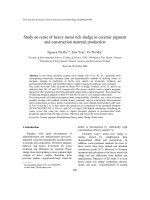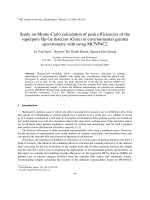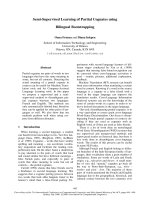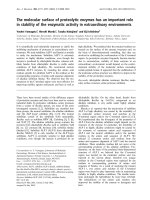Báo cáo " Study on wave prevention efficiency of submerged breakwater using an advanced mathematical model " pot
Bạn đang xem bản rút gọn của tài liệu. Xem và tải ngay bản đầy đủ của tài liệu tại đây (386.54 KB, 7 trang )
VNUJournalofScience,EarthSciences24(2008)118‐124
118
Study on wave prevention efficiency of submerged
breakwater using an advanced mathematical model
Phung Dang Hieu*
Center for Marine and Ocean-Atmosphere Interaction Research
Received 7 August 2008; received in revised form 3 September 2008.
Abstract. The paper presents the results of a numerical study on the interaction of waves and a
submerged breakwater. The numerical study is the application of an advanced numerical model
named as CMED, which is based on the Narvier-Stokes equations and VOF (Volume of Fluid)
method, and has been previously developed by the author. The consideration is paid for the
investigation on the influence of the characteristics of the breakwater on the variation of some
parameter coefficients, such as reflection, transmission and energy dissipation coefficients. Based
on the systematic analysis of the numerical results, the wave prevention efficiency of the
breakwater is discussed. The results show that there are an effective range of the water depth at the
top of the submerged breakwater and an effective range of the breakwater width in relation to the
incident wave length that produces the effective performance of the submerged breakwater
regarding to the wave prevention efficiency. The results of this study also confirm that the energy
dissipation due to wave breaking processes is one of key issues in the practical design of an
effective breakwater.
Keyword: Submerged breakwater; Wave transmission; Wave prevention; Numerical experiment.
1. Introduction
*
Understanding the interaction of waves and
coastal structures in general and the interaction
of waves and submerged breakwaters in
particular, is difficult but very useful in practice
for design of effective breakwaters to protect
coastal areas from storm wave attacks.
Hydrodynamic processes in the coastal region
are very important factors for coastal
engineering design, in which the water wave
propagation and its effects on coasts and on the
coastal structures are extremely important. The
_______
*
Tel.: 84-914365198.
E-mail:
interactions between waves and a coastal
structure are highly nonlinear and complicated.
They involve the wave shoaling, wave
breaking, wave reflection, turbulence and
possibly wind-effects on the water spray. The
appearance of a coastal structure, for example a
breakwater, can alter the wave kinematics and
may result in very complicated processes such
as the wave breaking, wave overtopping and the
wave force acting on the structure. Therefore,
before a prototype is built in the field, normally
engineers need to carry out a number of
physical modeling experiments to understand
the physical mechanisms and to get an effective
design for the prototype. This task gives
specific difficulties sometime, and the cost of
P.D.Hieu/VNUJournalofScience,EarthSciences24(2008)118‐124
119
experiments is an issue. One of the main
problems in small-scale experiments is that
effects of the small scale may cause
discrepancies to the real results. To minimize
the scale effects, in many developed countries,
for example, US, Japan, Germany, England, etc,
engineers build large-scale wave flumes to
study the characteristics of prototype in the
nearly real scale or real scale. These can reduce
or even avoid the scale effects. However, there
are still some remaining problems, such as high
consumption costs and undesirable effects of
short wave and long wave reflections.
Therefore, the contamination of the action of
long waves in experimental results is still
inevitable.
Recently, some numerical studies based on
the VOF-based two-phase flow model for the
simulation of water wave motions have been
reported. Hieu and Tanimoto (2002) developed
a VOF-based two-phase flow model to study
wave transmission over a submerged obstacle
[1]. Karim et al. (2003) [5] developed a VOF-
based two-phase flow model for wave
interactions with porous structures and studied
the hydraulic performance of a rectangle porous
structure against non-breaking waves. Their
numerical results surely showed a good
agreement with experimental data. Especially,
Hieu et al. (2004) [2] and Hieu and Tanimoto
(2006) [4] proposed an excellent model named
CMED (Coastal Model for Engineering Design)
based on the Navier-Stokes equations and VOF
method for simulation of waves in surf zone
and wave-structure interaction. Those studies
have provided with useful tools for
consideration of numerical experiments of wave
dynamics including wave breaking and
overtopping.
In this study, we apply the CMED model to
study the interaction of waves and a submerged
breakwater and to consider the wave prevention
efficiency of the submerged breakwater. The
study is focused on the influence of submerged
breakwater height and width on the
transmission of waves.
2. Model description
In the CMED model (Hieu and Tanimoto,
2006) [4], the governing equations are based on
the Navier-Stokes equations extended to porous
media given by Sakakiyama and Kajima (1992)
[6]. The continuity equation is employed for
incompressible fluid. At the nonlinear free
surface boundary, the VOF method [3] is used.
The governing equations are discretized by
using the finite difference method on a
staggered mesh and solved using the SMAC
method. Verification of the CMED model has
been done and published in an article on the
International Journal of Ocean Engineering.
The proposed results revealed that the CMED
model can be used for applied studies and be a
useful tool for numerical experiments (for more
detail see [4]).
3. Wave and submerged breakwater
interaction
3.1. Experiment setup
Study of wave and submerged breakwater is
carried out numerically. In the experiment, a
submerged breakwater with the shape of
trapezium having a slope of 1/1.3 at both
foreside and rear side, is set on a horizontal
bottom of a numerical wave tank. The water
depth in the tank is constant equal to 0.375m.
The incident waves have the height and period
equal to 0.1m and 1.6s, respectively. The
breakwater is kept to be the same sharp while
the height and width of the breakwater are
variable.
First, experiment is done with varying
heights of breakwater in order to investigate the
variation of wave height distribution and
PhungDangHieu/VNUJournalofScience,EarthSciences24(2008)118‐124
120
reflection, transmission and dissipation
coefficients versus the variation of water depth
at the top of the breakwater. For this purpose,
the breakwater height is changed so as the water
depth at the top is varying from 0 to 0.375m.
Second, after the first experiment, the next
investigation is carried out using some selected
water depths at the top of the breakwater and a
set of breakwater widths varying from 0.1 to
1.1 times incident wave length. This experiment
is to get the influence of the breakwater width
on the wave prevention efficiency of the
breakwater. Fig. 1 presents the sketch of the
experiment.
Fig. 1. Description of experiment.
3.2. Results and discussion
The first numerical experiment is to
investigate the influence of the height of the
breakwater on the transmission waves and
reflection effects. The numerical results are
shown in the Fig. 2. The notations
T
K
,
R
K ,
d
K
are used for the transmission, reflection and
energy dissipation coefficients. From this
figure, it is seen that the reflection coefficient
R
K gradually decreases versus the increase of
the normalized depth at the top of the
breakwater, or versus the decrease of the
breakwater height. The quantity
T
d denotes the
water depth at the top of the breakwater. The
ratio
IT
Hd / (where
I
H is the incident wave
height) equal to zero means that the height of
the breakwater is equal to the water depth
h .
0
0.2
0.4
0.6
0.8
1
00.511.522.533.54
Fig. 2. Variation of reflection, transmission and
dissipation coefficient versus water depth at the top
of the breakwater.
For the transmission and dissipation
coefficients, the variation is very different. The
transmission and dissipation coefficients
respectively decrease and increase when the
height of the breakwater increases (or when the
water depth at the top of the breakwater
decreases). Especially, when the water depth at
the top of the breakwater decreases to
approximately 1.2, there is an abrupt change of
the transmission as well as dissipation
coefficients, and this change keeps up to the
value of
IT
Hd / =0.6. After that, the decrease
of
IT
Hd / results in not much variation of
T
K
and
d
K . This can be explained that due to the
presence of wave breaking process as the water
depth at the top of the breakwater less than the
incident wave height (
IT
Hd / <1), the wave
energy is strongly dissipated and results in the
significant change of the dissipation coefficient,
and consequently results in the change of the
transmission coefficient. When
T
d decreases
more,
d
K also increases, however, there is a
limited value of
IT
Hd / (the value is
approximately equal to 0.6 in Fig. 2), the more
reduction of
T
d does not give a significant
change of
d
K . This can be explained that this
value of
IT
Hd / is enough to force the wave to
break fully, and most wave energy is dissipated
due to this forcing. Therefore, more reduction
of
T
d could not give more significant energy
h
T
d
B
a
SWL
P.D.Hieu/VNUJournalofScience,EarthSciences24(2008)118‐124
121
dissipation. This suggests that there is an
effective range of water depth at the top of
submerged breakwater that can give a good
performance of the breakwater in prevention of
waves.
From the results of the first experiment,
there is a question: is there any effective range
of the width of the breakwater regarding to the
wave prevention? To answer this question, the
second experiment is considered with three
values of
IT
Hd / equal to 0.6, 0.8 and 1.0.
Thus, there are three sets of experiments. In
each set, the change of breakwater width
B
is
considered with the ratio
LB / in the range
from 0.1 to 1.1, in which
L is the wave length.
0
0.5
1
1.5
-2 -1.5 -1 -0.5 0 0.5 1 1.5 2
Fig. 3. Wave height distribution a long the
breakwater in the case of
0.1=
I
T
H
d
.
0
0.5
1
1.5
-2 -1.5 -1 -0.5 0 0.5 1 1.5 2
Fig. 4. Wave height distribution along the
breakwater in the case of
6.0=
I
T
H
d
.
Fig. 3 shows the distribution of wave height
around the breakwater for the case of
IT
Hd / =1.0. There are two lines presenting the
wave height distribution for two cases
LB / =0.1 and LB / =0.7. At the foreside of the
breakwater (left side of the figure), it is the
presence of the partial standing waves due to
the combination of the incident and reflected
waves. At the rear side of the breakwater, the
wave height is smaller than that of the incident
wave due to the reflection at the fore side and
the wave energy dissipation at the breakwater.
We can see that the wider breakwater gives
smaller transmitted waves at the rear side. From
the figure, it is also seen that the wave breaking
is not so strong. In Fig. 4, the distribution of
wave height is somewhat similar to that in Fig.
3; however, the wave breaking in Fig.4 is much
stronger. The transmitted wave height is about
0.7 times the incident wave height for the case
LB / =0.1 and comparable to the case LB / =0.7
in Fig. 3. With the case
LB / =0.7 in Fig. 4, the
transmitted wave height is only 0.5
I
H . The
wave height difference between the cases
LB / =0.1 and LB / =0.7 is about 0.25 in
T
K .
This means that approximately 6.25% of wave
energy has been dissipated due to different
types of wave breaking. Therefore, the wave
energy dissipation due to breaking processes
should be considered in practical design of
effective breakwaters.
Fig. 5 presents the time variation of total
wave energy, which is normalized by the
incident wave energy, at the rear side of the
breakwater. In this figure,
t
is the time and
T
is the wave period. We can see that after four
wave periods, the transmitted wave comes to
the observed location. The wave energy is
exponentially increasing during duration of
approximately 4 times the wave period
T
.
After that, the wave energy becomes stable and
approaches a constant value. It is clearly seen
that when the ratio
LB / is small, the change of
wave energy versus the variation of
LB / is
fast; this is presented in the figure by the big
distance between two adjacent lines. When
LB /
is greater than 0.6, the distance between
two adjacent lines becomes smaller and the
change of wave energy is slow down versus the
change of the ratio
LB / . The same aspect can
PhungDangHieu/VNUJournalofScience,EarthSciences24(2008)118‐124
122
be seen in the Fig. 6 by the presentation of
variation of three quantities, the reflection,
transmission and dissipation coefficients, versus
the change of the breakwater width. It is worthy
to note that the dissipation coefficient is
calculated using the formula
22
1
TRd
KKK −−= .
0
0.1
0.2
0.3
0.4
0.5
0.6
0.7
0.8
0246810
B/L=0.8
B/L=0.9
B/L=1.0
B/L=1.1
B/L=0.7
B/L=0.6
B/L=0.5
B/L=0.4
B/L=0.3
B/L=0.2
B/L=0.1
0
0.1
0.2
0.3
0.4
0.5
0.6
0.7
0246810
B/L=0.8
B/L=0.9
B/L=1.0
B/L=0.7
B/L=0.6
B/L=0.5
B/L=0.4
B/L=0.3
B/L=0.2
B/L=0.1
0
0.1
0.2
0.3
0.4
0.5
0.6
0246810
B/L=0.8
B/L=0.9
B/L=1.0
B/L=0.7
B/L=0.6
B/L=0.5
B/L=0.4
B/L=0.3
B/L=0.2
B/L=0.1
Fig. 5. Time variation of normalized total wave
energy behind the breakwater
(a)
0.1=
I
T
H
d
; (b) 8.0=
I
T
H
d
; (c) 6.0=
I
T
H
d
.
0
0.2
0.4
0.6
0.8
1
0 0.2 0.4 0.6 0.8 1 1.2
0
0.2
0.4
0.6
0.8
1
0 0.2 0.4 0.6 0.8 1 1.2
0
0.2
0.4
0.6
0.8
1
0 0.2 0.4 0.6 0.8 1 1.2
Fig. 6. Variation of reflection, transmission and
energy dissipation versus breakwater width
(a)
0.1=
I
T
H
d
; (b) 8.0=
I
T
H
d
; (c) 6.0=
I
T
H
d
.
In Fig. 6, the reflection coefficient
R
K
varies in a complicated manner versus the
change of
LB /
. At first, the coefficient
R
K is
(
a)
(b)
(
c)
(
a)
(b)
(c)
P.D.Hieu/VNUJournalofScience,EarthSciences24(2008)118‐124
123
fluctuated and then it becomes more stable
when the width
LB /
increases. The reflection
coefficients
R
K in three cases (Fig. 6a, b, c) are
all less than 0.2 and not so much different
among them. This means that the height of the
breakwater
a greater than
I
Hh − (or 0.1<
I
T
H
d
)
can gives not much change in the reflection
function of the breakwater. The transmission
coefficient
T
K decreases gradually versus the
increase of
LB / .
There is a variation range of
LB / , in which
the change of
T
K is very fast, minus steep
slope of
T
K can be clearly observed from all
cases ((a) 0.1=
I
T
H
d
; (b) 8.0=
I
T
H
d
; (c)
6.0=
I
T
H
d
). The increase of
LB /
comes to a
specific value, after that the increase more of
LB /
can not result in a significant decrease of
T
K . The specific value is changeable from case
to case. We can see in Fig. 6 that for the case
0.1=
I
T
H
d
, the specific value of LB / is roughly
0.7; for the case
8.0=
I
T
H
d
and 6.0=
I
T
H
d
, it is
0.6. These specific values can be considered as
the effective values of the width of the
breakwater, because if the breakwater is built
up with the bigger value of
LB / , the decrease
of
T
K is not much. This means that the
transmitted wave height behind the breakwater
reduces not significantly, therefore
consumption cost for the material (for example,
to build the wider breakwater) is not so
effective. It is also seen from the figure that for
the higher breakwater, we get the smaller
effective value of
LB / . The dissipation
coefficient in Fig. 6 varies in the same manner
as the transmission coefficient but inversely. At
first, when the value
LB / increases, the
coefficient
d
K increases fast, after that, its
change is slow down and
d
K approaches a
constant value when the ratio
LB / reaches the
effective value. The coefficient
d
K represents
the energy lost due to the shallow effects (such
as friction, wave breaking, turbulence etc.),
thus, the bigger value of
d
K means lager wave
energy dissipation. From Fig. 6c, if we consider
value of
LB / =0.5, we can see that 50% of
wave height is reduced when the incident wave
is passing over the breakwater, and the value of
d
K =0.85 gives us the information that about
72% of wave energy (equal to
()
2
d
K ) is
dissipated at the breakwater. Where as there is
only about less than 4% of wave energy (equal
to
(
)
2
R
K ) is stopped and reflected by the
breakwater. Therefore, the wave energy
dissipation due to breaking should be
considered as the key issue to design an
effective wave prevention breakwater in practice.
4. Conclusions
In this study, numerical experiments for the
interaction of waves and submerged breakwater
have been investigated using the advanced
Navier-Stokes VOF-based model CMED. The
first experiment was carried out for nine cases
of variation of the breakwater height to
investigate the influence of the water depth at
the top of the submerged breakwater on the
wave prevention function of the breakwater.
The second experiment was done for 33 cases
of variation of the width of the breakwater in
the combination with three selected breakwater
heights in order to study the effect of
dimensionless breakwater width on the wave
reflection, transmission and dissipation
processes. The results show that there is an
effective range of the submerged breakwater
related to the incident wave length that makes
the performance of the submerged breakwater
be effective in preventing the incident waves.
The effective value of the water depth at the top
of the submerged breakwater is within the range
PhungDangHieu/VNUJournalofScience,EarthSciences24(2008)118‐124
124
from 1.0 to 0.6 times the incident wave height,
and the effective value of the breakwater width
is in the range from 0.5 to 0.7 times the incident
wave length.
The results of this research also show that in
the case of the selected breakwater, the
maximum reflection effect can give only 4% of
wave energy to be reflected; where as almost
70% of the incident wave energy can be
dissipated at the breakwater. Those results
suggest that the energy lost due to wave
breaking processes is the key issue and should
be considered carefully in the practical design
to get an effective submerged breakwater
regarding to the wave prevention efficiency.
Acknowledgements
This paper was completed within the
framework of Fundamental Research Project
304006 funded by Vietnam Ministry of Science
and Technology
References
[1] P.D. Hieu, K. Tanimoto, A two-phase flow
model for simulation of wave transformation in
shallow water, Proc. 4th Int. Summer
Symposium Kyoto, JSCE (2002) 179.
[2] P.D. Hieu, K. Tanimoto, V.T. Ca, Numerical
simulation of breaking waves using a two-phase
flow model, Applied Mathematical Modeling 28
(2004) 983.
[3] P.D. Hieu, Numerical simulation of wave-
structure interactions based on two-phase flow
model, Doctoral Thesis, Saitama University,
Japan, 2004.
[4] P. D. Hieu, K. Tanimoto, Verification of a VOF-
based two-phase flow model for wave breaking
and wave-structure interactions, Int. Journal of
Ocean Engineering 33 (2006) 1565.
[5] M.F. Karim, K. Tanimoto, P.D. Hieu, Simulation
of wave transformation in vertical permeable
structure, Proc. 13
rd
Int. Offshore and Polar
Eng. Conf., Vol.3, Hawaii, USA, 2003, 727.
[6] T. Sakakiyama, R. Kajima, Numerical simulation
of nonlinear waves interacting with permeable
breakwaters, Proc. 23
rd
Int. Conf., Coastal Eng.,
ASCE, 1992, 1517.









